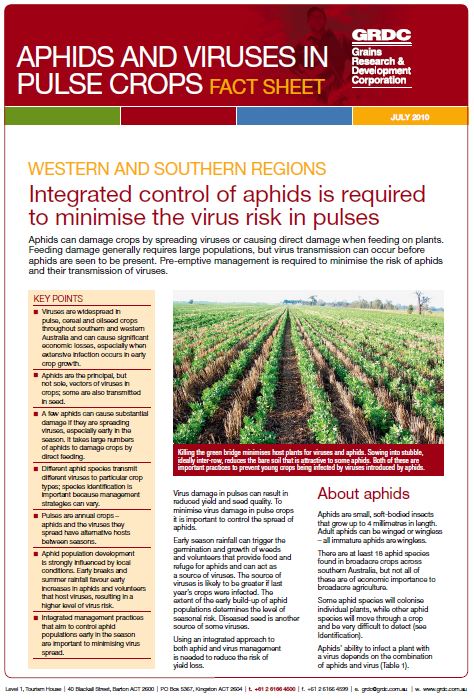Aphids and Viruses in Pulse Crops Factsheets
Aphids and Viruses in Pulse Crops Factsheets
Published: 12 Jul 2010

Integrated control of aphids is required to minimise the virus risk in pulses
Aphids can damage crops by spreading viruses or causing direct damage when feeding on plants.
Feeding damage generally requires large populations, but virus transmission can occur before aphids are seen to be present. Pre-emptive management is required to minimise the risk of aphids and their transmission of viruses.
Virus damage in pulses can result in reduced yield and seed quality. To minimise virus damage in pulse crops it is important to control the spread of aphids.
Key Points
- Viruses are widespread in pulse, cereal and oilseed crops throughout southern and western Australia and can cause significant economic losses, especially when extensive infection occurs in early crop growth.
- Aphids are the principal, but not sole, vectors of viruses in crops; some are also transmitted in seed.
- A few aphids can cause substantial damage if they are spreading viruses, especially early in the season. it takes large numbers of aphids to damage crops by direct feeding.
- Different aphid species transmit different viruses to particular crop types; species identification is important because management strategies can vary.
- Pulses are annual crops – aphids and the viruses they spread have alternative hosts between seasons.
- Aphid population development is strongly influenced by local conditions. early breaks and summer rainfall favour early increases in aphids and volunteers that host viruses, resulting in a higher level of virus risk.
- Integrated management practices that aim to control aphid populations early in the season are important to minimising virus spread.
Want to link to this publication?
Use www.grdc.com.au/GRDC-FS-AphidsandVirusesinPulses to ensure your link remains current and up-to-date!
Region: South; West
